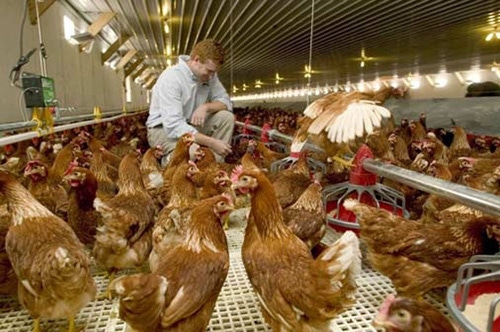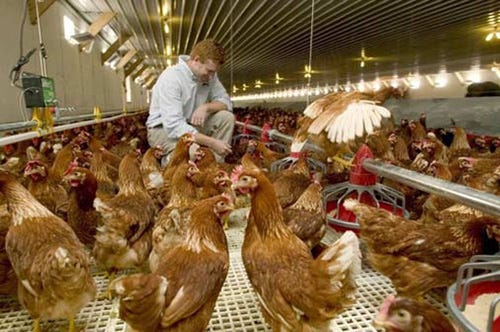Certified Humane label gets new standards from HFAC
March 11, 2015


Humane Farm Animal Care (HFAC) announces new standards for products that are labeled Certified Humane and either "Free Range" or "Pasture Raised." There is currently no legal definition for "Free Range" or "Pasture Raised" in the United States, therefore these terms are often used on poultry packaging with no unilateral definitions for the consumer to trust. HFAC's 28-member Scientific Committee has spent nearly two years reviewing all of the current research, which has resulted in new standards for the Certified Humane label.
Humane Farm Animal Care (HFAC) has revised their laying hen standards, which now divide the "Free Range" section of the standards into "Pasture Raised" and "Free Range." The "Free Range" section was originally written for what is now defined as a "Pasture Raised" system; the revised standards add a third category for birds which are outdoors seasonally. This change in standards means that Certified Humane producers wishing to use the terms "Pasture Raised" or "Free Range" on packages must now meet the requirements of the newly defined categories.
Dr. Ruth Newberry, associate professor at the Norwegian University of Life Sciences, chaired the Poultry Committee within HFAC's Scientific Committee. The Scientific Committee, and the producers had input and the Standards Committee did the final review. That process included review of animal research and visits to farms to review various outdoor systems.
The USDA's (and industry standard) definition for "Free Range" is that birds must have "outdoor access" or "access to the outdoors." In some cases, this can mean access only through a "pop hole," with no full-body access to the outdoors and no minimum space requirement.
HFAC's Certified Humane "Free Range" requirement is 2 sq. ft. per bird. The hens must be outdoors, weather permitting (in some areas of the country, seasonal), and when they are outdoors they must be outdoors for at least 6 hours per day. All other standards must be met.
HFAC's Certified Humane "Pasture Raised" requirement is 1,000 birds per 2.5 acres (108 sq. ft. per bird) and the fields must be rotated. The hens must be outdoors year-round, with mobile or fixed housing where the hens can go inside at night to protect themselves from predators, or for up to two weeks out of the year, due only to very inclement weather. All additional standards must be met.
Pasture Raised and Free Range producers must meet all the standards in addition to those specific to the Pasture Raised and Free Range housing systems.
"Any product labeling terms that are important to consumers need to be clearly defined. The Certified Humane labeling program is in place to assure a trusted product for consumers who care about how animals are raised and slaughtered for food." says Adele Douglass, HFAC's executive director. "While it takes time for the entire industry to adapt best practices, we at HFAC have the opportunity to break ground, and we do so every year as we revise and raise our standards."
Without any legal definitions for the terms, HFAC's previous "Free Range" standards were written for what is now defined as "Pasture Raised" standards and had a requirement of 2.5 acres per 1,000 birds (108 sq. ft per bird), which is the standard space requirement based on the British Free Range Standard and was a recommendation of the "Soil Association," an organization founded in 1946, which focuses on sustainable farming and preventing soil degradation. As consumer demand has increased for Certified Humane products, HFAC realized a need to separate the terms to define farms that had "outdoor access" and create a standard for "Free Range" versus those that were actually "Pasture Raised."
Currently, there are already three "Pasture Raised" egg companies on the program: Vital Farms (Austin, TX), White Oak Pastures (Bluffton, GA) and Ayrshire Farm (Upperville, VA). The only 100 percent "Free Range" company to be on the program, so far, is Happy Egg Co. (San Francisco, CA).
In addition to the revised best science-based standards that encompass both "Free Range" and "Pasture Raised" hens, HFAC's current Animal Care Standards for Laying Hens include standards for the rearing of laying hens in barns either with or without outdoor access. Cages of any type (including furnished cages) have always been prohibited. The minimum space requirements for barn-raised chickens include clean air (less than 10 parts per million (ppm) of ammonia), 15 percent of the floor space must have litter for the hens to dust-bathe, perches must be provided at 6" per bird and at least 20 percent of those perches must be elevated. There are requirements for feeder space and drinker space, as well. All animal byproducts are prohibited, as are antibiotics.
Industry definitions & findings:
HR 3798 Legislation, written and supported by both the United Egg Producers (UEP) and the Humane Society of the US (HSUS), and introduced in the last Congress, defines "Free Range" as:
(1) 'Eggs from free-range hens' to indicate that the egg-laying hens from which the eggs or egg products were derived were, during egg production - - (A) not housed in caging devices; and (B) provided with outdoor access.
Consumer Reports - Greener Choices evaluation of the claim "Free Range" states:
WHAT THIS GENERAL CLAIM MEANS: The USDA has defined "free range" or "free roaming" for poultry products but not for eggs. For other products carrying the "free range" label, there is no standard definition for this term.
CONSUMER UNION EVALUATION: Free range (or free roaming) is a general claim that implies that a meat or poultry product, including eggs, comes from an animal that was raised in the open air or was free to roam. Its use on beef is unregulated and there is no standard definition of this term. "Free Range" is regulated by the USDA for use on poultry, only, (not eggs) and the USDA requires that birds have been given access to the outdoors but for an undetermined period each day. USDA considers five minutes of open-air access each day to be adequate for it to approve use of the "Free Range" claim on a poultry product. "Free range" claims on eggs are not regulated at all. To learn more about what is meant by this term, consumers must contact the manufacturer.
Source: Humane Farm Animal Care
.
About the Author(s)
You May Also Like


